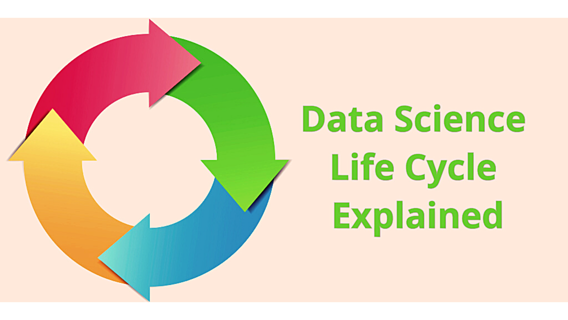Data Science Lifecycle Explained: From Raw Data to Real-Time Applications

Ever wonder how companies like Netflix know what you’ll watch next or how banks can flag a purchase as fraud within seconds? Behind these everyday miracles is the lifecycle of data science, a systematic approach that transforms raw data into action-packed insights.
Did you know that by 2025, the collected quantity of global data will reach 175 zettabytes? (market.us)
For this much volume of data, proper data management and handling are required; that’s where the workflow and applications of data science play a huge role.
Whether you are an experienced data science engineer or an aspiring one, knowing this lifecycle is what will enable you to derive the real value from data.
Understanding the Data Science Lifecycle
In general, there are six stages in the lifecycle: problem definition, data collection, data cleaning, data analysis, model building, and deployment. Let’s check out each of those steps, so you can see how they fit together.
Step 1: Problem Definition — Laying the Groundwork
All successful data projects begin with a well-defined problem. You need to know what question you’re trying to answer before writing any code. Such as a retailer that asks, “Can we forecast which products customers are going to buy next month?”
It is now time for domain experts and business owners to get together. You define the project objectives, specify what you will measure, and determine what kind of data you need. Even the most sophisticated analytics tools can only produce impactful results if you have a clearly defined goal.
Step 2: Getting Information — Collecting What We Need
With that in mind, once you understand what it is you want to solve, get ready to gather data. Data, meanwhile, is pulled in from a host of places — customer databases to sensors to APIs, and even social media. But more data is not always better — quality trumps quantity by a mile.
Step 3: Data Cleaning -- The Foundation Laying the Groundwork for Success
Raw data is messy — it probably has errors, duplicates, and missing values. It involves cleaning up 'dirt' so that the info being used is as accurate and consistent as possible when analyzed.
In this step, you deal with missing data, drop unwanted fields, and transform your data to a usable format.
Step 4: Analyzing the Data — Making Sense of What Counts
This is where data visualization comes in — serving as a tool that helps you discover hidden patterns, trends, and correlations.
Data scientists can visually analyze large datasets with the help of Tableau, Power BI, or Python libraries like Matplotlib and Seaborn, among other tools.
For instance, a health care researcher could plot how a patient’s heart rate changes over time to help spot early signs of sickness. Data visualization turns numbers into stories — which makes it easier for decision-makers to understand what is going on and why it matters.
At this stage, you are also doing statistical analysis to find correlations and test hypotheses. The aim is not only to describe events, but also to begin predicting what is happening next.
Step 5: Building the Data Science Model
This is where the machine learning in data science comes into the picture. You now have algorithms that can learn from the data and make guesses or classifications.
To the extent that your aim is, you would find:
● Supervised learning for such tasks as sales prediction or spam detection.
● Unsupervised learning to discover customer segments or uncover irregularities.
● Reinforcement learning for decision-making problems such as autonomous driving.
A data science model is a smart assistant that’s trained to learn patterns and make predictions. But it isn’t magic — the quality of your model is critically dependent on how well you trained it: that you used clean, balanced data.
Step 6: Deploy the Model — Make The Solution Come Alive
Deployment is the point where your data science model becomes real. It is integrated into an application or system so that it can make predictions automatically.
Machine learning models like those in e-commerce, recommending products for customers as they shop. AI models speed up the diagnosis of diseases for medical doctors in the field of healthcare.
In this case, a data science engineer needs to ensure that the model works well, scales well, and keeps on delivering in production.
Deployment also involves continuous monitoring. Models can become outdated as data inevitably shifts, requiring periodic updates and retraining to ensure accuracy.
Real-Time Applications of Data Science
That’s the great thing about data science: It’s not confined to just one industry. It’s changing the way we live and work in hundreds and hundreds of small ways.
a) Healthcare
Data science models are applied toward predicting outbreaks of diseases, personalizing treatments, and allocating resources within hospitals. With machine learning, early signs of cancer could show up in medical images, improving diagnosis time.
b) Finance
Use of machine learning in data science: Banks use this technology to detect fraudulent transactions, evaluate creditworthiness, and automate investment strategies. Data visualization software also lets analysts monitor financial trends as they happen.
c) Retail and E-commerce
Predictive analytics is utilized by Retailers for demand prediction, personalization of customer recommendations, and inventory management. It helps cut back on waste and enhance customer satisfaction.
d) Manufacturing
Factories rely on sensor data and predictive maintenance models to prevent equipment failures before they occur. With good training, a data science model can save millions of dollars by reducing or eliminating downtime.
e) Transportation
Whether it’s optimizing the route of delivery vehicles or providing drivers with real-time feedback to increase their autonomous driving skills, data science engineers have a significant part to play in how transportation companies remain safe and efficient, and can also reduce fuel consumption.
0 comments
Be the first to comment!
This post is waiting for your feedback.
Share your thoughts and join the conversation.
